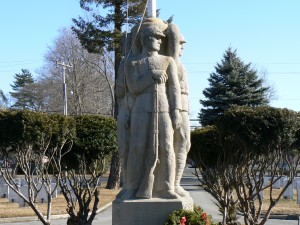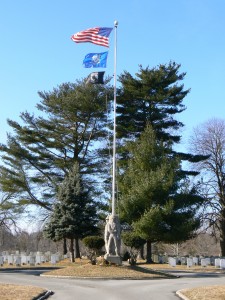 A four-sided sculpture at the base of a flagpole in the center of the Veterans’ Cemetery next to Darien’s Spring Grove Cemetery honors 2,184 veterans from Connecticut and several other states.
A four-sided sculpture at the base of a flagpole in the center of the Veterans’ Cemetery next to Darien’s Spring Grove Cemetery honors 2,184 veterans from Connecticut and several other states.
Many of the veterans buried in the cemetery lived at the nearby Fitch Home for Veterans and Their Orphans, which was the first such facility for veterans when it opened in 1864.
The monument, dedicated in 1936, features four figures representing veterans from the Civil War, the Spanish-American War and World War I. On the west face of the monument, a Civil War soldier is standing with his right arm supported by a rifle. On the east face, a sailor represents veterans of the Spanish-American War. On the south face, a stylized Doughboy figure is standing with his right arm held above his head (the significance of this gesture escapes us). On the north face, there is a muscular figure whose meaning also eludes us. As the Connecticut Historical Society description of the monument phrases it, “The symbolism of the fourth figure is not clear.”
 The sculptor, Karl Lang, was a local resident who also contributed to the carvings at Mount Rushmore.
The sculptor, Karl Lang, was a local resident who also contributed to the carvings at Mount Rushmore.
The flagpole sits at the center of a small traffic island and is surrounded by four evergreen bushes. The flagpole also sits at the center of 11 rows of headstones that radiate from the center in eight sections, creating a square pattern that is best appreciated in an aerial view such as this one.
The Fitch Home for Veterans and Their Orphans was founded in 1864 by Benjamin Fitch, a Darien native and dry goods magnate who was one of the nation’s first millionaires by the start of the Civil War. Fitch helped to organize a regiment, and promised to care for any veterans who were wounded in action. In 1864, Fitch donated five acres and $100,000 (an estimated $1.4 million in 2009 dollars) and built a hospital, chapel, library, residence hall and administrative buildings. A year later, the facility expanded to house children who were orphaned by the war.
In 1888, the facility was taken over by the state of Connecticut. The veterans’ home expanded a number of times between then and 1940, when the state moved the facility to a new home in Rocky Hill.
The former chapel building was moved across Norton Avenue in 1950, and is used today by the local VFW post as well as for community and social events. The cemetery was closed to new veteran internments in 1964.
Sources:
Connecticut Historical Society: Civil War Monuments of Connecticut
Tags: Darien


